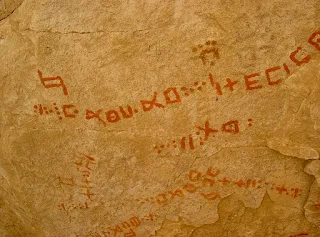Introduction :
Tifinag is an ancient script that is used to write Berber languages spoken in North Africa, especially in Morocco, Algeria, and Libya. The script has a long history, dating back to pre-Islamic times, and is believed to have influenced the development of Arabic script. This article aims to explore the Tifinag language, its history, and its cultural significance. In doing so, we will also examine the current state of Tifinag and its potential future.
Sahara - Tassili N'Ajjer - Graffitis en tifinagh | Flickr- created by Thomas
The History of Tifinag :
Tifinag is believed to have originated in the 3rd century BC in the region now known as Libya. The script was used by the Berber people, who were the original inhabitants of North Africa. Tifinag was originally used to write religious texts and poetry, and it was also used for communication between tribes. The script remained in use throughout the centuries, but it was not until the 20th century that it became standardized.
In the early 20th century, the French colonial authorities in North Africa recognized the importance of Tifinag and began to promote its use. In 1920, the first Tifinag alphabet was created, and it was later revised in 1930. The alphabet contained 33 letters, and it was used to write Berber languages spoken in Morocco and Algeria.
However, the use of Tifinag declined in the mid-20th century due to the increasing influence of Arabic in North Africa. Many Berber people began to adopt Arabic script, which was seen as more modern and practical. As a result, Tifinag was largely forgotten and became a symbol of cultural oppression.
Revitalization of Tifinag :
In the 1990s, there was a renewed interest in Tifinag, particularly in Morocco. The government recognized the cultural importance of Tifinag and began to promote its use in education and media. In 2003, the Royal Institute of Amazigh Culture (IRCAM) was established to promote the Berber language and culture, and Tifinag made an official script for writing Berber languages in Morocco.
The revitalization of Tifinag has been a slow process, but there have been some successes. In Morocco, Tifinag is now taught in schools, and it is used in some newspapers and websites. In Algeria, Tifinag has also been recognized as an official script for writing Berber languages, and it is taught in some schools.
Cultural Significance of Tifinag :
Tifinag has a deep cultural significance for the Berber people. It is seen as a symbol of their ancient history and cultural identity. Tifinag is also seen as a way of preserving the Berber language, which is an important part of Berber culture.
Tifinag is used to write many Berber languages, including Tamazight, Tarifit, and Tashelhit. These languages have a rich oral tradition, and Tifinag has been used to transcribe this tradition. Tifinag has also been used to write Berber poetry, which is an important part of Berber culture.
Conclusion :
Tifinag is an ancient script that has played an important role in the history and culture of North Africa. Although its use declined in the 20th century, there has been a renewed interest in Tifinag in recent years. Tifinag is now recognized as an official script for writing Berber languages in Morocco and Algeria, and it is taught in some schools. Tifinag is a symbol of the Berber people’s cultural identity and is seen as a way of preserving the Berber language and culture for future generations.
Bibliography :
Aghezzaf, Brahim. “Tifinagh Script: The Writing System of the Amazigh Language.” International Journal of Language and Linguistics, vol. 7, no. 4, 2020, pp. 161-174.
Chaker, Salem. “The Tifinagh Alphabet: Its Origins and Significance.” Scripta & e-Scripta, vol. 13, 2014, pp. 5-26.
Dallet, Jean-Marie. Dictionnaire kabyle-français, Imprimerie nationale, Paris, 1982.
Deverdun, Gaston. “Les inscriptions libyco-berbères de l’Atlas et du Hoggar.” Journal de la Société des Africanistes, vol. 21, no. 2, 1951, pp. 137-171.
Naït-Zerrad, Kamal. “Amazigh (Berber) Writing System in North Africa.” Written Language & Literacy, vol. 15, no. 2, 2012, pp. 223-237.
Taine-Cheikh, Catherine. “The Tifinagh Alphabet: A Brief Overview.” Al-Masaq: Islam and the Medieval Mediterranean, vol. 26, no. 1, 2014, pp. 72-90.
Tilmatine, Mohand. “The Berber Language.” Language and Linguistics Compass, vol. 2, no. 2, 2008, pp. 369-391.
Chaker, Salem. “The Tifinagh Alphabet: Its Origins and Significance.” Scripta & e-Scripta, vol. 13, 2014, pp. 5-26.
Dallet, Jean-Marie. Dictionnaire kabyle-français, Imprimerie nationale, Paris, 1982.
Deverdun, Gaston. “Les inscriptions libyco-berbères de l’Atlas et du Hoggar.” Journal de la Société des Africanistes, vol. 21, no. 2, 1951, pp. 137-171.
Naït-Zerrad, Kamal. “Amazigh (Berber) Writing System in North Africa.” Written Language & Literacy, vol. 15, no. 2, 2012, pp. 223-237.
Taine-Cheikh, Catherine. “The Tifinagh Alphabet: A Brief Overview.” Al-Masaq: Islam and the Medieval Mediterranean, vol. 26, no. 1, 2014, pp. 72-90.
Tilmatine, Mohand. “The Berber Language.” Language and Linguistics Compass, vol. 2, no. 2, 2008, pp. 369-391.
Zouaoui, Ammar. “A Critical Overview of the Tifinagh Alphabet.” International Journal of Language and Linguistics, vol. 2, no. 2, 2015, pp. 93-104.




No comments:
Post a Comment